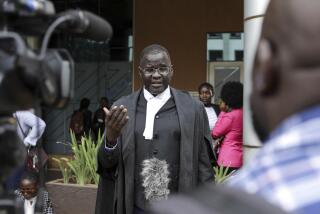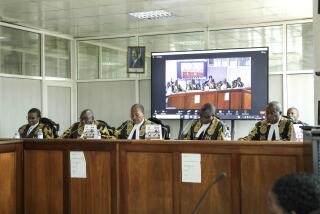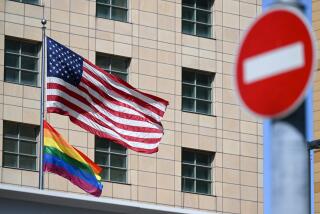Op-Ed: Islamic State’s war on gays

This image taken from a militant website associated with Islamic State extremists, posted May 23, 2015, purports to show a suicide bomber, with the Arabic bar below reading: “Urgent: The heroic martyr Abu Amer al-Najdi, the attacker of the (Shiite) temple in Qatif”, which the Islamic State group’s radio station claimed responsibility for.
Twenty-six-year-old Faraj Ali Shalwi was a dapper dresser. And while his tight-knit circle of friends in his Libyan hometown, Derna, admired his sense of style, his neighbors treated him with suspicion. They said that his clothes were “contemporary.” They also said they were “effeminate.”
Shalwi’s sartorial choices were different from those of most men, but they were probably not dangerous. That changed in November when the local Islamic Youth Shura Council raised the black flag of the extremist group Islamic State, pledging allegiance to the caliphate. It installed a new local government, an Islamic police force and an Islamic court.
Islamic State-allied militias in eastern Libya have committed numerous atrocities, including summary executions, public floggings and beheadings. Unidentified assailants were responsible for at least 250 seemingly politically motivated assassinations in 2014. Because of the collapse of the judicial system in the region, no one has been prosecuted or punished for these killings.
Gay men or men perceived to be gay run a particular risk in Islamic State-controlled territories. According to the International Gay and Lesbian Human Rights Commission, Islamic State executed at least 17 men in Syria and Iraq accused of indecent behavior, sodomy and adultery between June 2014 and March 2015.
Derna’s roughly 100,000 inhabitants live between mountains, the desert and the Mediterranean Sea. Just 50 miles west is the larger city of Bayda, where Shalwi graduated as a pharmacist from Omar Al-Mukhtar University. He knew this city well, and even after university it remained the hub of his social life. In Bayda, with its quarter-million inhabitants, he could be a bit more relaxed about expressing his homosexuality, albeit among a group of trusted friends.
It was in this city that he met Saad Fakhakhiri, 40, who ran a clothes shop in Derna’s historic downtown. Soon the two became inseparable. Shalwi confided to a friend that he was in a relationship with Fakhakhiri and liked him. He was frustrated because it was risky to express his feelings publicly. Any sexual relations outside marriage as well as “lewd acts” are punishable with up to five years in prison under the Libyan Penal Code.
Although they were careful, the relationship that blossomed between Shalwi and Fakhakhiri did not go unnoticed. In November, the two men were strolling on Derna’s boardwalk, talking and joking, when an Islamic police patrol stopped, searched and questioned them. The patrol warned them to not loiter in that area. It was intimidating at the time and, in retrospect, ominous. Soon after the boardwalk incident, Shalwi and Fakhakhiri disappeared.
Through word of mouth, Shalwi’s friends learned that the two men had been detained by the Islamic police in December on suspicion of homosexual conduct in a parked car. They were held in an unknown location for five months by extremist groups that pledged allegiance to Islamic State.
On April 30, the two men and a third also accused of homosexuality, Nassib Jazawi, were brought to the courtyard of the Sahaba Mosque, where masked men awaited them. Blindfolded, kneeling and with their hands tied, they were shot in the back of the head. The masked men yelled “Allahu akbar!”
Shame born of social stigma prevented the families from holding funeral services for the three men. Nor would they receive condolences. It was as if nothing had happened.
These weren’t the first executions in Derna of men accused of homosexuality. An activist in Derna told Human Rights Watch that 45-year-old Fathi Katish, who was relatively out as a gay man, was shot near his home in March 2014 by unidentified assailants.
And in July, 26-year-old Yousef Ghaithy, who had been jailed in 2008 under Moammar Kadafi’s rule for three years on sodomy charges, was thrown by unidentified armed men from the edge of a mountain.
Islamic State has published at least eight online visual reports depicting executions of accused homosexuals in Iraq and Syria. On Tuesday, it posted photographs taken in Nineveh province, northern Iraq, showing a man accused of homosexuality being held by his feet over the edge of a high building and then dropped in front of a crowd of onlookers.
Although establishing the veracity of the stories behind the gruesome images is almost impossible, the fact that they are broadcast as executions for “sodomy” or the “act of the people of Lot” has terrorized people who run afoul of Islamic State’s warped morality. In this sense, the truth of the accusations is less important than the message.
I watched a video of the April 30 execution, recorded by a witness standing at a distance. It is the routine nature of the execution that is so unsettling. In the aftermath men slowly leave the square. One wags his finger, laughing, while another hobbles across the screen on crutches.
What is more chilling? Is it the casual chatter of the men departing the execution site, as if leaving a football match, or is it the white vans reversing into the square to collect three bodies?
Graeme Reid is LGBT rights director at Human Rights Watch.
This snapshot of Shalwi’s life was provided by a journalist based in Benghazi with whom I am in communication. He spoke by phone to six men who knew Shalwi and were willing to talk.
Follow the Opinion section on Twitter @latimesopinion and Facebook
More to Read
A cure for the common opinion
Get thought-provoking perspectives with our weekly newsletter.
You may occasionally receive promotional content from the Los Angeles Times.






